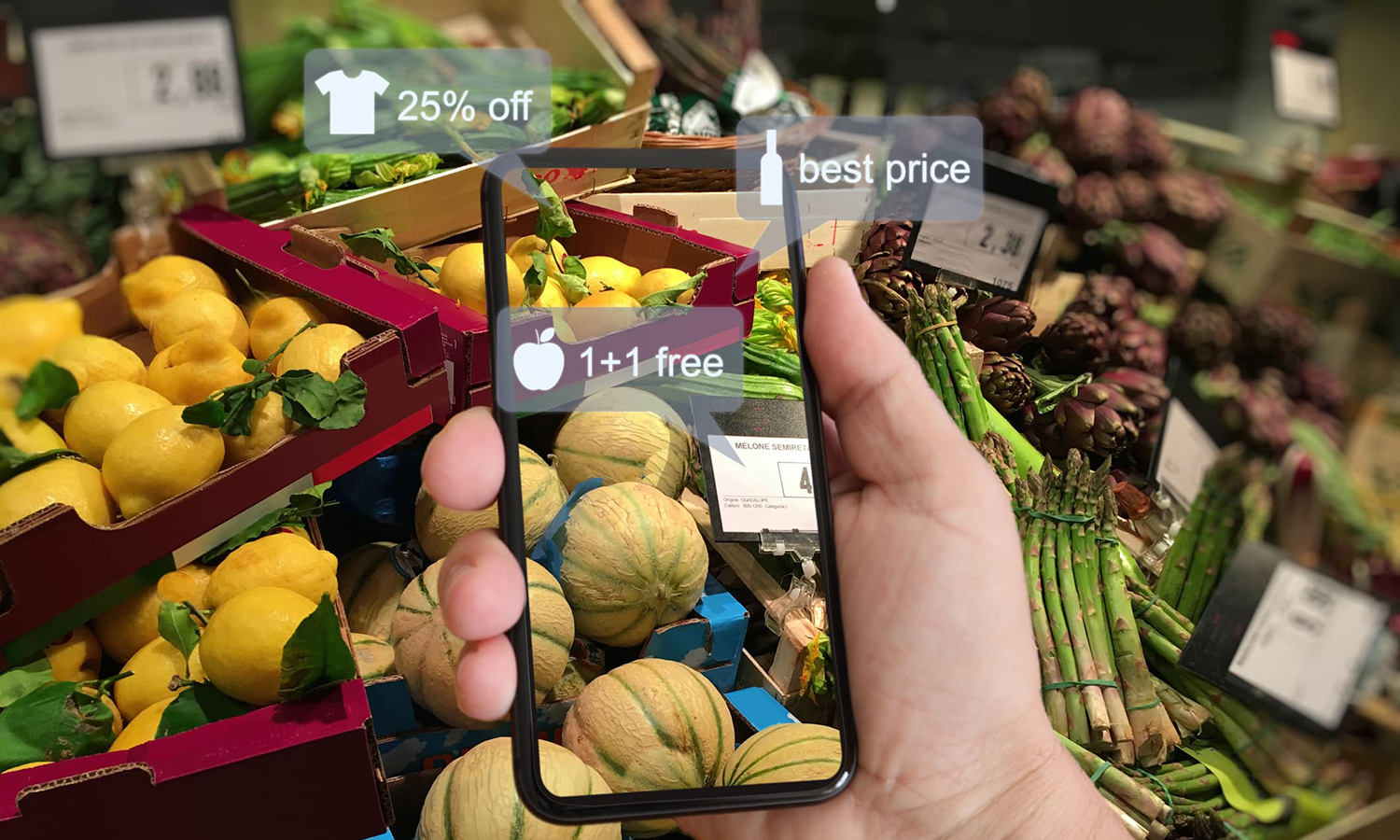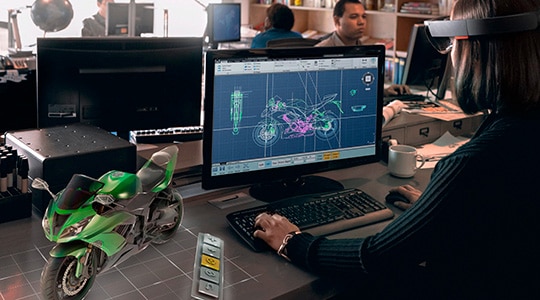Augmented reality (AR) has transformed how we experience the world around us, and its impact on the food industry is no exception. Imagine pointing your smartphone at a menu and seeing dishes come to life on your screen, with ingredients, preparation methods, and even the story behind each recipe vividly displayed. That's where the expertise of an augmented reality app development company becomes invaluable. These innovators are at the forefront of blending digital information with the physical environment, specifically within the culinary sector.
Integrating augmented reality into food experiences is a pivotal innovation, dramatically enhancing how consumers interact with menus and learn about their meals. By leveraging the capabilities of an augmented reality app development company, the culinary world is witnessing a revolution. Through AR, diners no longer glance at a list of dishes; instead, they explore interactive displays that reveal ingredients, origins, and the stories behind their food, all before taking a bite.
Augmented reality in food enriches the dining experience by offering customers an immersive way to explore dishes through their smartphones. This advancement offers an enriched, immersive dining journey, making every meal an opportunity for discovery and connection. It highlights the essential role of augmented reality app development companies in bridging the gap between digital innovation and culinary delight, ensuring a seamless, engaging experience for every user.
The Impact of Augmented Reality in Transforming the Food Sector

Augmented reality technology has notably changed the food sector, offering both businesses and consumers new ways to connect with food and beverages. Restaurants, cafes, and food brands now incorporate augmented reality to create immersive menus that allow patrons to visualize dishes in 3D before ordering. Such innovations enhance customer satisfaction and aid in making informed dietary choices.
Moreover, AR applications in the food industry extend beyond the dining experience. For instance, augmented reality in business practices within the food sector includes training staff more effectively through virtual simulations of kitchen procedures, reducing the learning curve, and improving efficiency.
Packaging has also seen a transformation with AR, where scanning a product with a smartphone can reveal a wealth of information, from sourcing details and nutritional data to recipes and preparation videos. This level of transparency builds trust and deepens the consumer's connection to the brand. On the marketing front, augmented reality food campaigns offer a novel way to engage customers. By turning the act of exploring a product into an interactive experience, brands create memorable impressions that encourage sharing on social media, amplifying their reach.
Food safety compliance, an essential aspect of the food industry, benefits from AR through real-time information and guidelines displayed to workers, ensuring standards are met consistently.
In essence, augmented reality introduces a dynamic shift in how food businesses operate and engage with customers, offering tools that enrich the culinary experience, streamline operations, and foster a transparent, informative relationship between consumers and their food choices.
The Rise and Development of Food AR
The journey of AR food technology from its inception to its current prominence showcases rapid advancement and creativity. Initially, AR apps found their niche in gaming and entertainment. However, visionaries in the food industry quickly recognized AR's potential to transform the dining and shopping experience. As interest grew, the focus shifted toward how to build an AR app tailored for foodies and food businesses alike.
The development process of AR apps for food involves intricate programming, user interface design, and a deep understanding of culinary desires. Programmers and designers collaborate to create applications that project virtual images of dishes onto the real-world environment of the user, providing a visual and interactive experience. This process demands a thorough understanding of both AR technology and the gastronomic expectations of users.
Early adopters in the restaurant sector used AR to enhance customer engagement, allowing diners to scan a QR code and see a 3D model of their meal before ordering. This innovation led to increased satisfaction and a reduction in order returns. Food retailers followed with AR apps that animated product stories and nutritional information when customers scanned items with their smartphones.
Significantly, AR food apps have democratized access to gourmet experiences, enabling users to explore exotic cuisines and learn cooking techniques from renowned chefs through virtual classes. This evolution reflects a broader trend toward digitalization in the food industry, where technology aims to satisfy our growing desire for convenience, information, and immersive experiences.
The rise of AR in food demonstrates a successful marriage between technology and culinary art. Digital innovation can enhance our connection to what we eat, making each meal an adventure waiting to be explored.
Program-Ace’s Delicious World of OishiiAirEating AR App

Discover the power of augmented reality in food marketing with our case study on OishiiAirEating. This AR app merges entertainment with cultural promotion, offering businesses a unique tool to captivate audiences and promote Japanese cuisine globally. Learn how this app can transform your marketing efforts.
Pros of Integrating AR into Food Experiences
Integrating AR into food experiences brings numerous benefits:
- It allows customers to see 3D models of dishes before ordering, enhancing decision-making and reducing dissatisfaction.
- Interactive menus through AR provide detailed insights into ingredients and nutritional information, catering to health-conscious diners.
- AR makes food education entertaining, with apps teaching cooking techniques or the history behind dishes.
- AR in food marketing creates engaging, shareable content, increasing brand visibility.
- For businesses, AR applications streamline operations, from training staff with virtual simulations to ensuring food safety standards through augmented prompts, improving overall efficiency and compliance.
For Business Owners
Enhanced customer engagement. By incorporating AR into your food business, you create an interactive and immersive dining experience that captures patrons' attention and encourages them to explore your menu in depth.
Informed decision-making. AR menus allow customers to visualize their orders before placing them, leading to higher satisfaction rates and fewer returned dishes.
Educational opportunities. Use AR to educate customers about the origins of dishes, ingredients, and nutritional information, promoting a more informed and health-conscious clientele.
Operational efficiency. AR technology can streamline training processes for new staff with virtual simulations, reducing the time and cost associated with traditional training methods.
Marketing innovation. Implementing AR in promotional strategies can differentiate your brand, offering unique experiences that customers are eager to share on social media and increasing your visibility.
Increased sales. Interactive AR experiences can boost customer engagement and encourage trying new dishes, leading to higher average order values.
Customer loyalty. Unique AR experiences foster a memorable connection between your brand and customers, encouraging repeat business and long-term loyalty.
For Customers
Visual clarity. Food augmented reality offers a 3D preview of dishes, helping you visualize what you are about to order, reducing uncertainty, and enhancing your dining experience.
Nutritional insight. With AR, you gain immediate access to detailed information about the nutritional content of your meal, making it easier to stick to dietary preferences or restrictions.
Engaging experiences. AR transforms the process of ordering food into an interactive adventure, making dining out or food shopping more enjoyable and memorable.
Learning journey. Discover the stories behind your favorite dishes, from their origins to the chefs who prepare them, all through the lens of AR, adding depth to every bite.
Efficient service. Restaurants utilizing AR can offer quicker and more accurate order processing, leading to a smoother and more satisfying dining experience.
Social sharing. AR experiences are not just fun; they are shareable. Snap and share your augmented food adventures on social media, turning meals into moments that captivate friends and followers.
Personalized choices. Food augmented reality can tailor recommendations based on your past preferences, allergies, or dietary needs, ensuring every meal perfectly suits your taste.
Challenges of Implementing AR in the Food Industry
Implementing augmented reality in the food industry faces several significant hurdles. The cost of initial setup and continuous development of AR applications represents a substantial financial commitment, often too steep for smaller enterprises. Another critical issue lies in adopting the technology itself; both patrons and employees must be willing and able to embrace AR, which can be daunting for individuals unfamiliar with such advanced tech. Furthermore, ensuring AR apps function flawlessly across various devices and operating systems requires constant technical refinement to avoid compatibility problems.
Creating a user-friendly experience demands deep knowledge in user experience design, a skill that may be scarce in traditional food industry contexts. Moreover, generating engaging and high-quality AR content, like 3D models of meals, needs creative talent and resources, presenting another layer of complexity. Privacy also becomes a concern, as the use of AR apps involves collecting and managing user data, necessitating strict compliance with data protection laws.
The technical maintenance needed to keep AR applications running smoothly adds to the operational costs and complicates matters further. Additionally, the food industry must gauge market readiness for such technology; the novelty of AR could lead to low consumer adoption if the market is not yet prepared for these advancements. Lastly, integrating AR technology seamlessly with existing restaurant management systems and workflows can be daunting, requiring careful planning and technical know-how, which might be outside the expertise of many food businesses.
Tips for Consumer Engagement Through Food AR
Introducing augmented reality into the food industry elevates the dining experience and opens new avenues for customer engagement. By following these tips, businesses can create meaningful and interactive connections with their patrons, ensuring that each encounter with food AR turns into a memorable journey.
1. Start simple. Launch your AR experience with intuitive designs that easily guide users, ensuring a smooth introduction to augmented reality in food.
2. Educate customers. Use AR to provide fascinating insights into the sourcing of ingredients, preparation methods, and the cultural background of dishes, making dining an educational experience.
3. Create interactive menus. Allow patrons to explore menu items in 3D before ordering, offering a virtual taste to help them make informed decisions.
4. Encourage social sharing. Design AR experiences that are both immersive and shareable, prompting users to spread the word on their social media platforms.
5. Offer rewards. Integrate loyalty programs with AR, rewarding customers for engaging with your AR features, such as scanning AR codes for discounts or free items.
6. Gather feedback. Use AR applications to collect customer feedback on the spot, providing valuable insights that can help refine your AR offerings.
7. Update regularly. Keep your AR content fresh and engaging by regularly adding new features or seasonal items, encouraging customers to return and explore what’s new.
8. Personalize experiences. Tailor the AR experience to individual preferences or dietary requirements, making each interaction feel unique and personal.
9. Invest in quality. Ensure the quality of your AR visuals and interactions to maintain user interest and engagement over time.
10. Promote widely. Use all available channels to promote your AR features, from in-store signage to online marketing, ensuring customers know about these innovative experiences.
To maximize the potential of food AR for enhancing customer engagement, businesses must stay innovative, responsive to feedback, and committed to delivering high-quality experiences. Embracing these strategies will delight and surprise customers and foster a loyal community around your brand, propelled by the cutting-edge fusion of technology and gastronomy.
AR Technology Trends in the Food Industry
Augmented reality technology in the food industry is evolving rapidly, bringing innovative trends that revolutionize how consumers interact with food and dining experiences. Restaurants now embrace AR to transform static menus into interactive displays, allowing customers to see realistic 3D models of dishes before ordering. This trend enhances the decision-making process and enriches the overall dining experience by providing a visual taste of what's to come.
Another significant trend is the use of AR for detailed nutritional information. With health-conscious eating on the rise, consumers demand more information about their food. AR applications meet this need by overlaying digital information onto physical products, revealing calories, ingredients, and allergens with just a scan.
Moreover, AR is taking food education and entertainment to new heights. Cooking tutorials and culinary stories come to life in one's kitchen, offering a hands-on learning experience that is both informative and fun. Such an approach engages users more deeply than traditional methods, making learning about food preparation and history an immersive adventure. The integration of AR into marketing strategies also stands out. Food brands are creating engaging AR campaigns that invite users to explore products in a fun and interactive way, significantly boosting brand engagement and customer loyalty.
Lastly, AR technology facilitates better training and compliance in food safety. Interactive AR guides provide staff with real-time information and procedures, ensuring high standards of hygiene and preparation are met efficiently. These trends underline AR's growing significance in the food industry, highlighting its potential to transform traditional practices into engaging, informative, and safe food experiences.
How AR Is Used Successfully in Food Brands
Augmented Reality is transforming the restaurant and food brand industry in novel and engaging ways. Here are some real-world examples showcasing the successful integration of AR:
Dutch Lady's Interactive AR
Aiming at families and children, Dutch Lady created an interactive AR experience. Customers could unlock engaging content by pointing their devices at the packaging, turning mealtime into an interactive adventure.
Jump into Africa
Kinder teamed up with FPP and Aircards to launch an innovative AR experience called 'Jump Into Africa' in Tesco stores. This WebAR portal transports users to the African Savanna to explore animated 3D safari animals and learn about them through infographics without needing an app. Accessible via in-store signage and flyers, the experience highlights the potential of WebAR technology for engaging customers in a retail setting, showcasing a successful inter-agency collaboration.
These examples underscore the versatility of AR in elevating customer experiences, from making informed decisions about meals to transforming dining into an immersive journey. Restaurants and food brands leveraging AR are setting themselves apart in a competitive industry and creating deeper connections with their customers.
Partner with Program-Ace to Bring Value to Your Customers
Partnering with Program-Ace, a leading software development company, ensures your business delivers exceptional customer value. By collaborating with us, you invest in innovative solutions tailored to meet consumer needs. Our expertise spans various industries, enabling us to craft unique experiences that stand out in the digital landscape. For a partnership that transforms your customer engagement strategies, contact us today. Together, we'll set new standards in delivering memorable experiences to your clientele.













